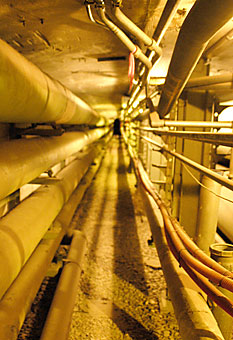 |
|
Cassandra Tomlin/Arizona Daily Wildcat
|
Pipes delivering steam and chilled water run from the basement of the Central Heating and Refrigeration Plant on North Mountain across campus in a network of tunnels more than 7 miles long.
|
|
|
By Evan Pellegrino
Arizona Daily Wildcat
Wednesday, October 12, 2005
Print this
State funding for energy has failed to increase as the UA continues to grow, prompting the university to find creative ways to keep the cost of powering the campus low.
"The state lets us grow but they don't provide more money for energy costs," said Joel Valdez, senior vice president of business affairs.
The UA has been spending money it doesn't have on energy, so in order to avoid further debt, the UA has implemented new ways to conserve energy, Valdez said.
Classrooms were 2 degrees warmer over the summer, and students can expect the rooms to be 2 degrees colder this winter, dropping from 72 degrees to 70 degrees, Valdez said.
Valdez said students and faculty have noticed the increase in classroom temperatures this semester and his office has received many complaints.
"People are less comfortable, but it's the most effective way to control the cost of energy," Valdez said.
To help keep the energy debt as low as possible without leaving the campus too uncomfortable, Faculties Management has been developing systems to conserve energy.
A system called "C3" was developed by the UA and implemented five years ago, said Albert Tarcola, Facilities Management director.
The system, which has brought worldwide attention to the UA for its effectiveness, is a way for Facilities Management to regulate the temperature of multiple buildings on campus from a single computer through "industrial grade digital controls," Tarcola said.
C3 allows management to raise or lower the temperatures of buildings at night when they are unoccupied. The system also allows the university to cut down on man-hours with the computer doing more work.
At night, during warmer months, management uses C3 to raise the temperature up to 90 degrees, the highest temperature that won't risk damaging computers, Tarcola said.
Currently 25 buildings are controlled by this system, and the goal is to have 80 to 90 percent of buildings controlled by C3 in three to four years, Tarcola said.
The majority of campus buildings are conditioned by air-handling systems using chilled water for cooling and hot water or steam for heating, Tarcola said.
At night, when it's coolest in the summer, ice and chilled water is produced to cool the buildings for the next day, Tarcola said.
The C3 system helps regulate the airflow system and creates a scheduling program, limiting the airflow when it's not needed.
To produce energy when there is high use during the midday hours, the UA spent $14 million to purchase two natural gas turbines three years ago.
Calculations at the time of purchase predicted that the electricity-producing turbines would save the university money within seven years, Tarcola said.
But natural gas prices have skyrocketed and may continue to rise, resulting in "tremendously high gas bills," Tarcola said.
Tarcola predicted that by January, natural gas prices will be two to three times the current prices, which will "impact us quite heavily."
Gas price increases have limited the turbines' effectiveness at saving the UA money, and the estimated time scale for the turbines to pay themselves off may be doubled, Tarcola said.
Despite the unexpected increase in the price of natural gas, Valdez said the gas turbines are still a good option as an alternative energy source from Tucson Electric Power.
Other efforts to cut energy costs include the installation of low-energy light bulbs in some campus buildings like the library, and increasing the use of reclaimed water for greenery to avoid spending money on energy to pump ground water, Valdez said.
With the rising cost of gasoline, the UA has been exploring options to use alternatively fueled vehicles, Valdez said.
Dick Roberts, UA budget director, said there hasn't been a significant difference in the money spent on energy over the past few years, which ranges from $12 million to $13 million. But considering how much the campus has grown, the relatively constant energy bills show how effective management has been cutting energy costs, he said.
From 1999 to 2003 the nonresidential space at the university grew more than 205,000 square feet, and the campus continues to grow, said Mercy Valencia, assistant vice president of the real estate administration.
Valdez said if it were up to him, the university would halt more building until it received more state funding for energy.
According to Valdez, there is currently a $6-million deficit because of energy costs so far this year.
Tarcola estimated efforts from his department have saved the UA $6 million to $8 million over the past three to four years.
